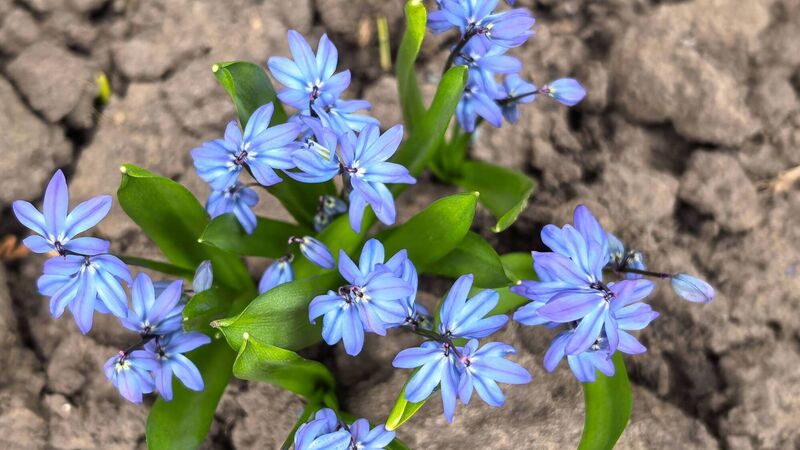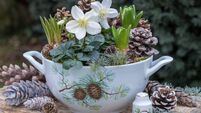Peter Dowdall: Get out in the garden and get planting this weekend. Your future self will thank you in spring

Planting bulbs such as this Scilla siberica now will not only bring colour next spring but also a valuable food source for pollinators, writes Peter Dowdall. File picture
There's a certain comfort in planting bulbs in November. The rest of the garden might be fading fast, with damp leaves clinging to paths, temperatures dropping and daylight fading fast, but there’s something wonderfully hopeful about kneeling down to tuck little bulbs into the energy of the soil, knowing that they’ll lie there quietly all winter, doing absolutely nothing that we can see and then, come spring, they’ll burst into life as if by magic.
November is, in many ways, the perfect month for it. The soil is still soft enough to dig, the temperatures are cool enough now that they don’t begin to grow too early and most importantly, there’s still time for them to settle in before the worst of the winter sets in.
People often think they’ve missed the boat if they didn’t get them in during September or October, but actually, November suits many bulbs perfectly. Tulips, for example, benefit from being planted later. They’re less likely to be affected by fungal diseases like tulip fire if the weather is cooler.
So, if you’ve been procrastinating, if those bags of bulbs are still sitting by the back door or in the shed, don’t feel guilty. Just get out there this weekend and start planting. Your future self, stepping out into the garden in February or March, will thank you for it.
There’s no need to draw up a planting plan or measure the gaps with a ruler; gardening isn’t like that. Bulbs are wonderfully forgiving, and as long as you plant them at the right depth, roughly two to three times their height and in well-drained soil, they’ll do their thing. I normally scatter them by hand and plant them where they fall, especially in informal borders or through grass. It gives a much more natural look, as though they’ve always been there.
There’s something magical about seeing daffodils, snowdrops, and crocuses pushing up through a lawn in spring. It’s as if the energy that lay dormant below the surface during the winter bubbles over in a celebration of colour as the world turns and the temperature and daylight hours begin to increase.
When you naturalise bulbs under trees or through grass, you’re creating a little moment of joy that will repeat itself year after year. And once established, most bulbs need very little from you. They’ll clump up and spread slowly over time, quietly multiplying underground each year.
If you’ve got trees or shrubs, planting bulbs underneath them is a clever way to make the most of that space. Those areas often look bare in spring before the leaves come out, and that’s exactly when bulbs thrive; they enjoy the winter and early spring light before the canopy fills in. Think of drifts of narcissus beneath a silver birch or bluebells naturalising under an old apple tree. It’s a simple way to create layers of interest, with bulbs taking centre stage when little else is happening.
While we might think of bulbs as purely decorative, some are also a lifeline for pollinators. Early flowers such as crocuses, snowdrops, and muscari are some of the first sources of nectar for bees emerging on warm spring days. When we plant bulbs now, we’re not just planning a show for ourselves; with the correct choice, we are also setting the table for the wildlife in spring.
Tulips are the drama queens of spring, of course, and they deserve their reputation. Their colours are so vibrant, their forms so varied, that you could design an entire garden around them.
If you’re feeling adventurous, try some of the more unusual bulbs too, things like Fritillaria meleagris, the snakeshead fritillary, with its chequered petals, or the delicate starry flowers of scilla. They may not shout as loudly as tulips, but they bring a quiet beauty to the garden and remind us of the wildflowers that once grew in meadows and woodlands before our gardens became so manicured.
If you don’t have much space, bulbs work wonderfully in pots too. Layer them like a lasagne, tulips at the bottom, then daffodils, then crocuses or muscari on top. You’ll get a long sequence of flowering, and the display will cheer up even the smallest balcony or patio. Just make sure your pots have good drainage; bulbs hate sitting in waterlogged compost.
By the time you finish, you’ll probably be muddy, your knees damp, and your back a little stiff, but you’ll also have done something deeply rewarding. You’ll have planted the beginnings of spring. And in a few months, when the days start to lengthen and those first green shoots appear, you’ll feel the quiet joy that only gardeners know, that sense of connection to the turning of the seasons and the knowledge that your small efforts, months previously, have once again paid off.

- Got a gardening question for Peter Dowdall? Email gardenquestions@examiner.ie












